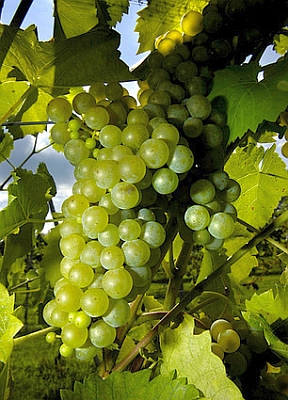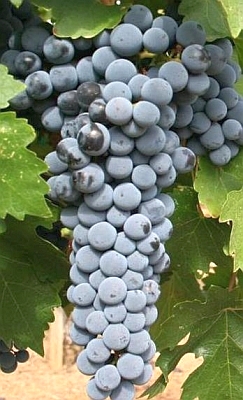
Chardonnay
Wine
Varietals

Cabernet Sauvignon
 Chardonnay |
Wine
|
 Cabernet Sauvignon |
| Of the approximately 10,000 documented
grape varieties, only 180 are made into wine. Each of these subspecies
have
names like Chardonnay, Cabernet Sauvignon, Merlot, Riesling and so
forth.
Here is a very brief description of the most popular varietals. And images of the great wine growing regions of France, Italy and California White:Bordeaux White Blends. Among the dry white wines of Bordeaux, particularly Graves, a blend (varying in percentages) of Sauvignon Blanc and Semillon is typical, with some 100% Sauvignon Blanc wines produced. Among sweet white wines, namely Sauternes, a typical recipe is 80% Semillon to 20% Sauvignon Blanc. Chardonnay. The king of white grapes and the darling of American palates. Chardonnay is offered in the New World (outside western Europe) as big, creamy and juicy with copious amounts of oak. In Burgundy, it is more complex and long-lived, with less tropical and more mineral and apple flavors. Chardonnay is an essential grape for méthode champenoise style wine around the world. It is by nature a rich, full-bodied wine that grows at its best in a relatively cool climate and can be distinctly floral and forward in the nose, with solid fruit of pears and melons and a clean green apple acidity with a certain flinty or chalky mineral quality. It often has a full, almost "oily", mouth feel with a long complex finish that lasts seemingly forever on the palate, with a perfect balance of fruit, acid and alcohol complexity that only Chardonnay can embody. Chenin Blanc. This grape is grown widely throughout the world (it is South Africa's most important grape) but rarely with the character of the Loire Valley's great Vouvray and Savennieres. Here the wines are powerful, pungent, great whether sweet or dry, and amazingly long-lived. Twenty years or more is the norm for good vintages. French Colombard. (Thompson Seedless) Widely planted grapes in California and South Africa being used in bulk wine (when not sold as table grapes or raisins). Traditionally important in Cognac, it has given way to Ugni Blanc, a much heartier variety. Garganega. The grape that provides the basis for a great Soave (wines from the Veneto region), the more Garganega and the less Trebbiano, the better the Soave. Gewürztraminer. A friendly and willing grape of the Muscat family with rich, pungent character and a nose like roses and a can of lychee nuts. It is good in Germany and Italy; great in Alsace where even when dry, it is so pungent it seems best with dessert. Good versions exist in the New World, particularly New Zealand. Muscat. The finest selection of the Muscat family, and a grape with several incarnations: Muscat Blancs á Petits Grains or Muscat Frontignan, Brown Muscat, Muscat d'Alexandria and Muscat Ottonel. Muscat á Petits Grains is the grape of southern French dessert wines (Muscat Beaumes de Venise), Italian wines (Goldenmuskateller), Italian sparklers (Moscato d'Asti and Asti Spumante), and even great Grecian wines (Samos). Brown Muscat is very rich and full in Australia's Liquer Muscats. Black Muscat also exists as a very dark variety. Pinot Gris. This pleasant and tasty grape offers good drinkability in Italy, Germany and the New World, but reaches its greatest heights in Alsace. It can taste of cream and apples and exists in well-made versions both sweet and dry. Riesling. One of the world's greatest grapes, Riesling was treated with the respect it deserved 100 years ago when its finest bottlings routinely were bid for higher prices that Lafite or Latour. Grown throughout the world with mixed results, America offers decent versions and Australia gives the most credible of the New World offerings. Alsace offers the finest outside of Germany, with higher, more obtrusive alcohol levels. All of Germany's great wines (except a tiny portion) are from Riesling. This grape is rich and crisp when young, but can age for ten years and beyond, depending upon the wine making style. Perhaps the most versatile white wine with food. Sauvignon Blanc. Blended with Semillon for dry white Bordeaux and used in smaller proportions for Sauternes and other French dessert wines. Grown to greatest effect in the Loire, especially in Pouilly Fumé and Sancerre. Surprisingly, New Zealand has, in scarcely more than a decade, produced wines of equal weight and class. In the rest of the New World, it is a good, and sometimes great, wine. Viognier. A rare but cultish grape originating in Condrieu in the northern Rhone Valley. It is now being rapidly planted in California where it yields good examples showing pungent Gewurz-like notes and rich Chardonnay-like flavors. Red:Bordeaux Blends. My preferred wines. Bordeaux, sometimes called Claret, is a wine made from a blend of different grape varieties. Although it varies from Château to Château, a typical Bordeaux recipe might be 70% Cabernet Sauvignon, 15% Merlot, 15% Cabernet Franc, while a likely St. Émilion or Pomerol blend might be 60% Merlot, 30% Cabernet Franc and 10% Cabernet Sauvignon. Cabernet Franc. This grape is related to Cabernet Sauvignon, with more fruit-basket style fruit and less tannin. Less long-lived than its cousin, Cabernet Franc brings an herbal note ranging from slightly tobacco-flavored to pungently leafy. Used in Bordeaux, especially in Pomerol, but important in the Médoc as a blender. 100% Cabernet Franc wines are offered elsewhere in the world, notably in the Loire Valley. Cabernet Sauvignon. A personal favorite. The king of red grapes. One of the most prominent grapes, it is found nearly everywhere in the world, but most celebrated grown in Bordeaux. In that region, Cabernet Sauvignon is usually blended with Merlot and Cabernet Franc to create the fabulous Bordeaux’s for which the region is distinguished. In Australia, it is often found with Shiraz as the blender. Cabernet Sauvignon is not only the principal component of the great Bordeaux wines, but also reigns as the grape varietal most widely known for putting the U.S. on the wine making map. It is grown prolifically throughout America, perhaps at its best in Napa, Sonoma and Washington State. Even though in this country we see many 100% varietally based wines, Cabernet Sauvignon is usually blended to add complexity and to round out the often tough-to-handle tannins which are characteristic of this wine in its youth. It is full-bodied, rich, firmly structured and powerful. It is reserved in the bouquet, yet the tell-tale black currant, dark berry, cedar and vanilla (from oak barrels) often show themselves. Some of its popular grape blending companions include Merlot, Cabernet Franc, Malbec and Petit Verdot. Carignan. A blending grape in Southern France of sometimes dubious distinction. The exception is at Banyuls, where it yields complex, dry, powerful aged red wines. Can be a major component of many Spanish red wines, increasingly better in quality. Also, found in North Africa. Gamay. Outside of the confines of Beaujolais, France, where in the top crus (Brouilly, Fleurie, et al) it can be rich, succulent and capable of aging ten years or more, Gamay makes a pleasant, simple and fruity wine. Gamay Beaujolais. A lesser clone of Gamay, it isn't quite as tasty as the true Gamay for which it is named. Grenache. This grape has many homes and faces. In Rioja, Spain, it is the grape second in importance to Tempranillo, and can show excellent character just north of Navarro. In southern France and the southern Rhône Valley, it reaches from excellent rosé, to pleasant, fruity drinker to imperial heights in Châteauneuf-du-Pape. Merlot. Often considered the "blending" grape of Bordeaux, this grape does offer softness on the Médoc. But it is the heart and soul of many, if not most, Pomerols and St. Émilions. In the New World, Merlot is widely available in varietally labeled offerings and intensely popular for its fruitiness and soft tannins (when grown with that style in mind). This is a grape that has been nearly as successful in its varied and diverse plantings throughout the world as Cabernet Sauvignon. Mourvèdre. Overlooked but great, this grape offers wonderful fruit and earthiness in Provence and the southern Rhône in France. Spain and the U.S. also show exciting versions. Nebbiolo. A personal favorite. Perhaps the finest grape of Italy. Nebbiolo offers rather soft versions as well as the monster agers of Barolo and Barbaresco. These tough and unyielding versions can improve for thirty years or more in great vintages, with flavors of cherry, tar and flowers when ripe. Pinotage. South Africa's cloning of Cinsault and Pinot Noir has yielded a wine of good distinction and friendly fruit. You can consider the wine the Zinfandel of South Africa. Pinotage is also successfully grown in New Zealand and other parts of the world. Pinot Noir. The classic grape of Burgundy, a model that intrigues and tantalizes winemakers around the world. Its rich fruits and earthy aromas combine with low tannins for a wine that is almost always drinkable despite any youth. It is, however, finicky and touchy, and most regions of the world still struggle with the grape in search of high quality. Pinot Noir also is an important component in many styles of sparkling wine and Champagne, adding structure, flavor and color. The grape does exceptionally well in California. Sangiovese. A personal favorite. The primary grape of Chianti as well as several well-known Chianti clones. Its sweet cherry and leather tones when aged are pure grace at their best and austere and charmless when made poorly. Syrah. The great grape of northern Rhône where some of the world's greatest wines (Hermitage, Cornas, Cÿte Rotie) are straight renditions of the grape. Grown in other countries, Australia (known as Shiraz) has pushed it to similar heights. Ironically, it functions as Australia's cheap red quaff as well. Syrah displays a spicy blend of black pepper and raspberries, with dark fruit undertones; full-bodied with smoke, tar and tannins Tempranillo. A personal favorite. The most important grape and the soul of Rioja, Spain. It has rich dark fruit flavors and decent ageing ability. Tiny amounts of Grazuelo used in Rioja bring smoky lushness and age worthiness to the blend Zinfandel. The origins of Zinfandel are subject to much debate. It can be traced to the genetically identical grape in Italy known as Primitivo and some believe it descended from the Croatian Plavac Mali and brought to California by early wine pioneers as early as 1834. It is generally full-bodied and potent, with a burly, brambly quality, and can provide a veritable fruit basket of raspberries, blackberries, dark cherries and plums. It is food-friendly and ages very well. However, most Zinfandel's are blended to be drunk while young, fresh and fruity. Thanks to the popularity of the white version, Zinfandel is California's most planted grape. 09/05/01 |
Nation Visitors Since March 8, 2013